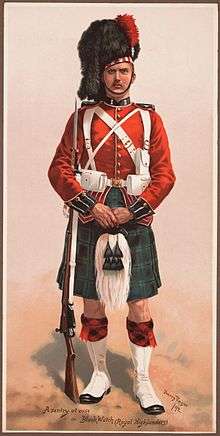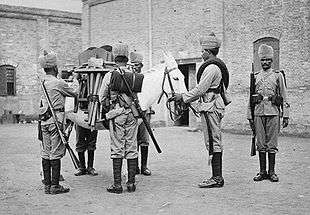Slade-Wallace Equipment
Valise Equipment, Pattern 1888 (also known as Slade-Wallace Equipment) was a leather harness used by the British Armed Forces.


History
The equipment was designed in 1888 by Colonel Slade and Major Wallace for use with the first .303-inch calibre rifles, replacing the Valise Equipment, Pattern 1870,[1] which had entered service in 1871. The Slade-Wallace Equipment weighed 25 pounds (11 kg), which was the lightest infantry equipment issued to British troops up to that time.[2] The belts, straps and pouches were made from buff coloured leather, which was whitened with pipe clay; the haversack was made of white canvas, except for rifle regiments which had black.[3]
It was the standard equipment worn by British and Imperial infantry during the Second Boer War. It proved unsuitable for holding modern ammunition, because the pouches had been designed before the introduction of the clip charger which allowed for rapid reloading, and could only accommodate individual rounds. The leather also tended to deteriorate during long periods in the field. After the war, review of the British Army's performance was conducted by the 1903 Royal Commission on the War in South Africa, which heard evidence that the Slade-Wallace equipment was "cumbersome, heavy and badly balanced" and "an absurdity". As a stop-gap measure, the leather 1903 Bandolier Equipment was issued, but it quickly proved to be unsuitable for infantry use and was itself replaced by the 1908 Pattern Webbing.[4]
The whitened Slade-Wallace equipment continued to be worn for ceremonial duties by the Brigade of Guards until 1939,[5] and other regiments in that era sometimes wore the whitened belt with Service Dress on formal occasions.[6]
Description
The complete equipment consisted of:
- one waistbelt
- two pouches
- a pair of braces with movable buckles and a keeper
- two greatcoat straps
- one mess tin strap
- one valise[7]
The leather was coloured according to regiment. It was left buff and then coloured black for rifle regiments, and whitened on the outer surfaces for infantry regiments.[1]
References
- Turner, Pierre (2007). Soldiers' Accoutrements of the British Army 1750-1900. Crowood Press UK. p. 86. ISBN 978-1861268839.
- Raugh, Harold E. (2004). The Victorians at War, 1815-1914: An Encyclopedia of British Military History. ABC-CLIO. p. 279. ISBN 978-1576079256.
- Herbert, Edwin (1990). The Second Anglo-Boer War. Sterling Publishing Co Inc. p. 29. ISBN 978-0788155604.
- Chappell, Mike (2000). British Infantry Equipments (2): 1908-2000. Osprey Publishing. p. 8. ISBN 978-1855328396.
- Wilson, James (2016). Up the Micks!: An Illustrated History of the Irish Guards. Pen & Sword Military. p. 20. ISBN 978-1473835634.
- Brayley, Martin; Chappell, Mike (2001). The British Army 1939–45 (1): North-West Europe. Men-at-Arms # 354. Botley, Oxford: Osprey Publishing. p. 40. ISBN 1-84176-052-8.
- "British P-1888 Slade-Wallace Equipment". International Military Antiques. Retrieved 4 August 2019.